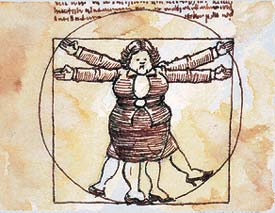[font=verdana,geneva,arial,sans serif][size=-2]
Sep 25th 2003
From The Economist print edition
[/size][/font]
[font=verdana,geneva,arial,sans serif][size=-1]
Shocking news: a market that is rejecting standardisation[/size][/font]
[font=verdana,geneva,arial,sans serif][size=-1]WE LIVE, it is said, in a world of standardisation: a place in which increasingly you can buy the same thingscappuccinos, food, cosmetics, fashionsin similar shops, in similar malls, in similar cities. The heart laments this and hopes it isn't really happening. The head, though, has to accept that it has advantages, for standardised products save time, reduce confusion, and may be cheaper and more predictable, especially when attached to a trusted brand. There is one market, however, in which hearts and heads alike are forcing things in a different direction: women's clothing. There, the customer is queen, and she seems to prefer confusion.[/size][/font]
[font=verdana,geneva,arial,sans serif][size=-1]It is not the fashions themselves that are flouting standardisation. It is the sizes in which they are sold. Once upon a time these were predictable and numerological, even if the numbers used varied from country to country. It did not matter if a size 12 dress in Britain was called a 38 in Germany and a 44 in Italy, for a simple conversion chart would suffice. No longer. Increasingly, size is a matter of vanity not of measurement, for women have, well, become larger in various ways (see
article). Not surprisingly, they would like to have their cake, eat it, and stay exactly the same dress size. Some clothing firms have accommodated such delusional desires by sticking to the same sizing numbers but making the clothes larger. Others have resorted to therapeutic wordspetite, regular, missy. In America, it is even possible to buy women's clothes in size 0; presumably negative sizing cannot be far behind. [/size][/font]
[font=verdana,geneva,arial,sans serif][size=-1]Men are, of course, going through the same dimensional change. They are not, however, encountering, or inviting, the same confusion. Occasionally it may be hard to work out what exactly is meant by medium or extra large, but mainly real measurements still rule. This may be because men have another option: for suit-wearers the best trick is to buy not the right new size but a size too big, for then the suit looks loose and people may be fooled into thinking you are getting slimmer, not fatter. Or perhaps their vanity is of a more primitive sort. A (possibly apocryphal) story about Winston Churchill has the great man recommending that among aid shipments sent during the second world war should be packages of British condoms, all large size but labelled small.[/size][/font]
[font=verdana,geneva,arial,sans serif][size=-1]But for women, meanwhile, shopping is becoming harder: more things must be tried on, taking more time, and buying online is a poor option. Central planners, ignoring the fact that this is the result of expressed female preferences, would want standardisation reimposed. Here's an alternative suggestion for our freer era: clothing firms could agree a standard sizing to be put on some sort of bar code or tag. Then those who want speed and clarity could buy (or be given) an electronic reader to find out the easily comparable truth. Those who would rather fool themselves can continue to do so by reading the written labels. Such are the workings of invisible hands.


